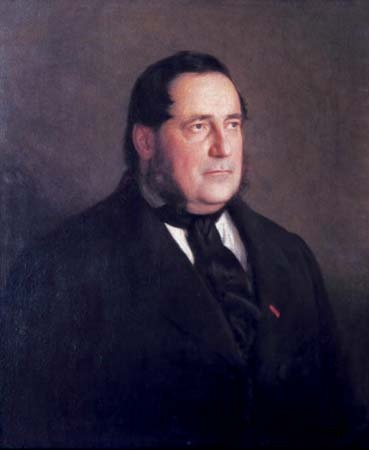Stifter, Adalbert
Austrian writer
born Oct. 23, 1805, Oberplan, Austria
died Jan. 28, 1868, Linz
 Austrian narrative writer whose novels of almost classical purity exalt the humble virtues of a simple life. He was the son of a linen weaver and flax merchant, and his childhood experiences in the country, surrounded by peasant craftsmen, provided the setting for his work.
Austrian narrative writer whose novels of almost classical purity exalt the humble virtues of a simple life. He was the son of a linen weaver and flax merchant, and his childhood experiences in the country, surrounded by peasant craftsmen, provided the setting for his work.Stifter was educated at the Kremsmünster abbey school. He enrolled as a law student in Vienna, but for the most part he attended scientific lectures and took no degree. After many years of precarious living as a tutor, artist, and writer, in 1840 he began to publish stories, including Der Condor (1840), Feldblumen (1841; “Wildflowers”), and Die Mappe meines Urgrossvaters (1841–42; “My Greatgrandfather's Portfolio”). In Brigitta (1844) the basic structure of his major work began to emerge: he saw that an inner unity of the landscape and people—a crucial part of life for him—must also determine the shape of his story. Collections of revised stories, Studien, 6 vol. (1844–50; “Studies”) and Bunte Steine (1853; “Colourful Stones”), brought him fame. In the important preface to the latter book, he expounded his doctrine of the “law of gentleness” as the enduring principle.
During the political turmoil of 1848–50, Stifter was deeply involved in the debate over the role of education; in 1850 he moved from Vienna to Linz, becoming an inspector of schools. The novel Der Nachsommer (1857; “Indian Summer”), his greatest work, depicts a young man learning and growing; the work radiates a still and sun-soaked beauty and a restrained idealism, set against the landscape Stifter loved. His epic Witiko (1865–67) uses medieval Bohemian history as a symbol for the human struggle for a just and peaceful order. Other stories followed, but he was too ill to finish his project of expanding Die Mappe meines Urgrossvaters into a novel: only the first volume was completed.
- Pittosporaceae
- Pitt-Rivers, Augustus Henry Lane-Fox
- Pittsburg
- Pittsburgh
- Pittsburgh glass
- Pittsburgh Penguins
- Pittsburgh Pirates
- Pittsburgh Steelers
- Pittsburgh Symphony Orchestra
- Pittsburgh, University of
- Pittsburg State University
- Pittsfield
- Pitt, Thomas
- Pitt, William, the Elder
- Pitt, William, The Younger
- pituitary gland
- pituitary tumour
- pitṛ
- Piura
- Pius II
- Pius III
- Pius I, Saint
- Pius IV
- Pius IX
- Pius VI